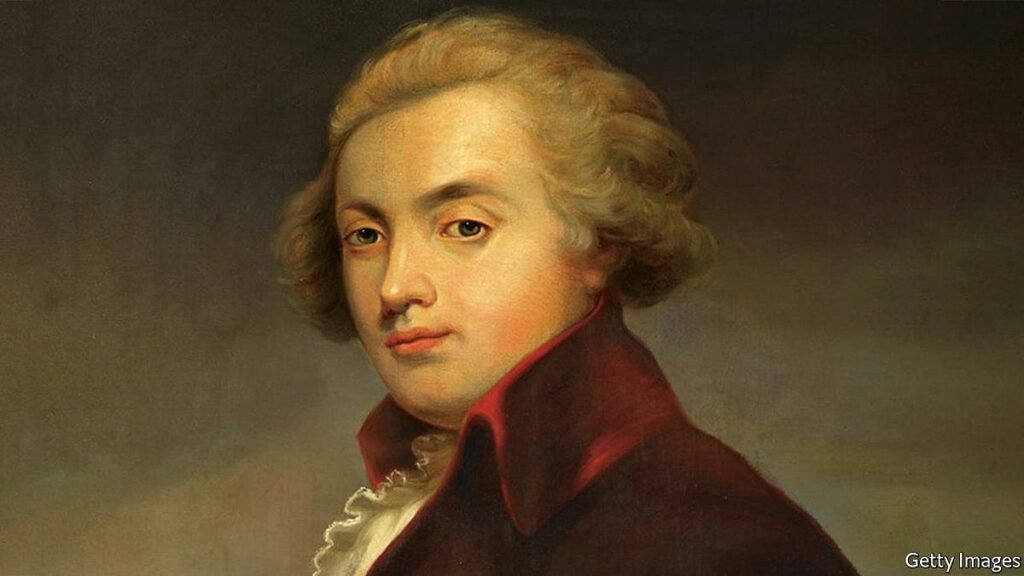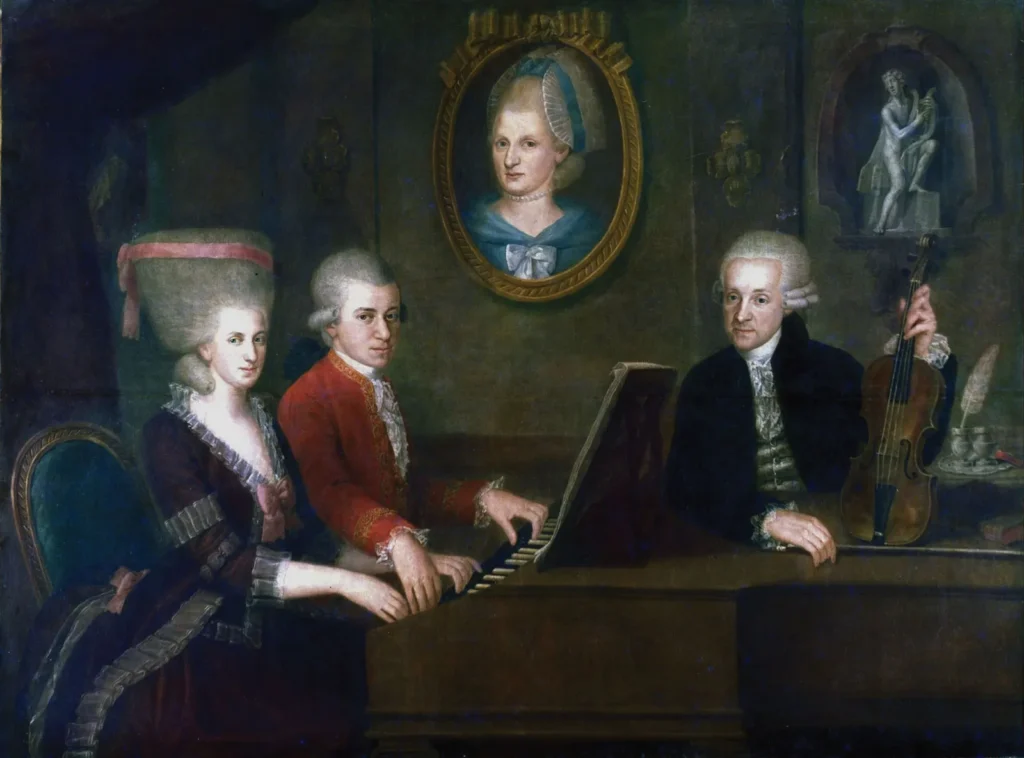Biographies Mozart Society of America

Wolfgang Amadeus Mozart was a musician (sometimes called a music composer), percussionist, and music instructor. He was born on January 27, 1756, and passed away on December 5, 1791. His full name, Johannes Chrysostomus Wolfgangus Theophillus Mozart, was given to him at baptism. Leopold and Anna Maria Mozart’s youngest child, he was.
At the time of his birth, Salzburg, which is now in Austria, was a free archbishopric city that was a component of the German Empire and the Bavarian Imperial Circle. Even as a young child, Mozart possessed extraordinary musical abilities. He toured Europe for many years with his parents and older sister “Nannerl,” entertaining aristocrats and royalty alike.
The young Mozart tried, but was unable, to establish himself as a composer in Paris. He took a temporary job in the archbishop’s court in Salzburg after his return. He knew Salzburg was brilliant, but he thought the man was too small for his abilities. After relocating, he experienced some success in Vienna. He married Constanze Weber, and the two of them have boys. Following a brief but enigmatic illness, he died in Vienna.
Mozart wrote more than 600 pieces of music, many of which are of the highest caliber. His works include the operas Don Giovanni, Cos fan tutte, The Marriage of Figaro, and The Magic Flute; symphonies in E-flat major, G minor, and C major (“Jupiter”); concertos for piano, violin, and various wind instruments; numerous chamber pieces; church works; minutes and other dances; songs; and the Requiem. Along with Bach and Beethoven, Mozart is regarded as one of the greatest composers to have ever lived.
Family
Born in Salzburg, Wolfgang Amadeus Mozart was the son of Leopold and Anna Maria Mozart. Leopold, who wrote the best violin primer ever, was also a violinist in the Salzburg archbishop’s orchestra.
Mozart showed great artistic skill from a very young age. He began composing small pieces of music and picking up the violin and harpsichord at the age of five.
The sister of Mozart was a bright young woman named Maria Anna. One of Johann Sebastian Bach’s sons, the musician Johann Christian Bach, happened to cross his way.
Sitting on Johann Christian Bach’s knee, he composed a fugue. After he joined the composer Joseph Haydn, they became close friends and frequently worked together in a string quartet capacity.
He staged the first performance of his opera Don Giovanni there in 1787, and his opera The Marriage of Figaro was highly regarded.
The Mozarts went back to Salzburg shortly after. Eventually, they went once again for Vienna in 1768, when Wolfgang, when he was twelve, led a production of his initial opera, Bastien und Bastienne. After taking a plane to Italy, he heard works by numerous well-known Italian composers, such as Gregorio Allegri, who composed the song Miserere.
To prevent any other chorus from copying it, the printed music was hidden from view. Mozart mastered the entire composition even though he had only listened to it once. In 1777, he traveled with his mother. In 1777, he traveled with his mother.
In an attempt to elevate her profile, Mozart intended to bring her to Italy, but his father got in the way.
Mozart and his mother had moved to Paris in 1778. His mother passed away there. Idomeneo was Mozart’s longest opera, but he wrote a few brief ones in his early years. The following year, he went to Vienna.
Like his father, he was working for the Salzburg Archbishop once more. He was formally deported after arguing with the Archbishop upon his return to Salzburg. Mozart moved to Vienna to live out the rest of his days.
Mozart’s father was not in favor of the marriage. They sometimes lived in severe circumstances notwithstanding Starch’s content being a devoted wife; nevertheless, like Mozart, she was not proficient with money.
Death and Illness
After spending a long time working on the symphony for the Magic Flute, Mozart conducted the opening ceremony, traveled to Baden, Austria, where he and his wife lived, then returned to Vienna after visiting Prague to start writing the Requiem.
While many were there when he passed away, the majority merely recorded their memories in writing. Later on, his sister-in-law said that Mozart was so swollen that the doctor had to order cold compresses since he had trouble turning over in bed and had a high body temperature.
Even in the eighteenth century, “fever and rash,” which were considered signs rather than a disease, were given as the cause of death.
According to epidemiological research published in the 18th issue of the Annals of Internal Medicine, he contracted an epidemic streptococcal infection.
The most common features were a cerebrovascular disease, TB, edema, malnutrition, and gastrointestinal disorders. Dr. Stroke says, “Like those before us, we’ve considered all the indications and symptoms.”
This blood vessel abnormality is the cause of stroke. But in the winter of 1791–1792, edema was the sole ailment that younger males had at a higher prevalence than in the years prior, suggesting a modest pandemic of an infectious disease.
Although Mozart’s sickness developed swiftly, edema is also associated with several chronic cardiac and kidney diseases.
In addition, Mozart experienced edema, back pain, and rash—all indications of a streptococcal infection. The substantial swelling may have been caused by the acute kidney disease known as glomerulonephritis, which can occasionally follow streptococcus.
Mozart Music
Mozart, like Haydn, is regarded as the master of the so-called Classical style. In music, tastes were shifting. The first major instrument on which great music had been composed was the piano, which had only lately become popular.
For Mozart, a symphony was usually a quick, simple way to pass the time when he was younger.
The symphony was painstakingly constructed by Mozart into a piece that might last up to half an hour. His concertos, especially the piano concertos, are far more advanced than anything that has been written previously.
Despite his apparent immaturity, Mozart had a deep understanding of human nature. This may be seen in his operas, where Mozart employed a range of nuanced effects to portray the story’s emotions.
An opera is among Mozart’s most significant works. He had a profound insight of human nature, which allowed him to compose music that flawlessly reflected the characteristics of the characters in the operas.
Along with numerous outstanding masterpieces, Mozart also produced a number of compositions that are more widely performed, including some tunes that are still in high demand today.
His serenade Eine Kleine Nachtmusik K525 and the Turkish Rondo from his Piano Sonata in A K331, which doubles as Symphony No. 1, are two of his most popular compositions. Later, in Augsburg, Stein pianos enthralled Mozart.
The music of Mozart and Haydn is among the best examples of the so-called Classical style. When he started writing, the Baroque period was coming to an end. People’s tastes in music were changing.
It was believed that form, proportion, and elegance were more important than contrast. The popularity of the piano had just grown, and Mozart was the first well-known composer to write music for it.
Mozart painstakingly scheduled the symphony to last for thirty minutes. His last three symphonies are outstanding works of art. His concertos are significantly more complex than anything that has ever been written, especially his piano concertos.

Works and Innovations
Mozart is recognized as the archetypal composer of the Classical era, much like Haydn. As a reaction to the fully developed Baroque complex, the Galant style predominated European music when he first began to compose.
Due in great part to Mozart, the late Baroque contrapuntal subtleties slowly made a comeback, controlled and governed by new forms, and adjusted to a new aesthetic and social context. Charles Rosen makes a strong point in his communication.
Understanding Mozart’s compositions and their structures requires an appreciation of both their harshness and sensuality.
Only then can we start to appreciate Mozart’s magnificence. Ironically, Schumann’s naive rendition of the G minor Symphony helps us to easily identify Mozart’s devil.
All of Mozart’s exquisite representations of pain and terror have an unexpectedly sensual quality.
Some are like the works of J. C. Bach, others have the simple, rounded binary shapes of the Viennese composers.
As Mozart developed, he included more Baroque-inspired components. For example, K. 201’s Symphony No. 29 in A major opens with a contrapuntal primary theme and plays around with different phrase lengths.
He was probably influenced by Haydn, who included three fugal finales in some of his 1773 quartets from his recently published Opus 20 collection.











Pingback: Mike Lindell Net Worth 2023; Age, Height, Wife & Biography
Pingback: Taylor Swift: Biography, Family, Education, Career, Height 2023 -